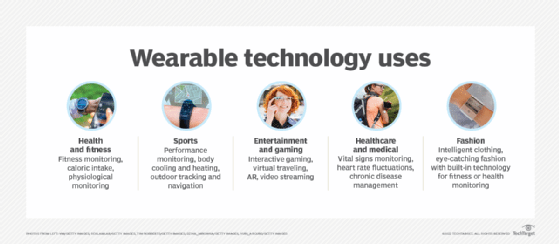Which Option Describes Wearable Technology
What is clothing technology?
Wearable engineering is any kind of electronic device designed to exist worn on the user's body. Such devices can take many dissimilar forms, including jewelry, accessories, medical devices, and clothing or elements of clothing. The term wearable computing implies processing or communications capabilities, just in reality, the sophistication amid wearables can vary.
The virtually sophisticated examples of vesture technology include bogus intelligence (AI) hearing aids, Google Glass and Microsoft'south HoloLens, and a holographic computer in the form of a virtual reality (VR) headset. An case of a less circuitous form of wearable technology is a disposable skin patch with sensors that transmit patient data wirelessly to a control device in a healthcare facility.
How does vesture technology piece of work?
Mod wearable applied science falls under a broad spectrum of usability, including smartwatches, fettle trackers such as the Fitbit Charge, VR headsets, smart jewelry, web-enabled glasses and Bluetooth headsets. Wearables work differently, based on the category they belong to, such as health, fitness or entertainment. Predominantly, wearable engineering science functions past incorporating microprocessors, batteries and connectivity to the cyberspace and so the collected data tin be synced with other electronics, such as mobile devices or laptops.
Wearables are embedded with congenital-in sensors that keep track of actual movements, provide biometric identification or assistance with location tracking. For case, activity trackers or smartwatches -- the well-nigh common types of wearables -- come with a strap that wraps effectually the user'southward wrist to monitor their concrete activities or vitals throughout the day.
While nearly wearables are either worn on the body or are attached to clothing, some function without any physical contact with the user. Prison cell phones, smart tags or computers tin can notwithstanding be carried effectually and track user movements. Other wearables utilize remote smart sensors and accelerometers to track movements and speed, and some use optical sensors for measuring heart rate or glucose levels. A common gene among these engineering science wearables is the fact they all monitor information in real fourth dimension.
What are some applications of clothing technology?
Consumer electronics, such equally smartwatches and fitness trackers, are prominent apply cases for article of clothing applied science. However, with the recent advancements in the internet of things (IoT) and AI, article of clothing technology is being incorporated into all types of scenarios -- from healthcare, navigation systems, consumer goods and professional sports to advanced textiles.

The following are the near popular current and next-generation applications of habiliment engineering science:
Epidermal skin technology. According to ScienceDaily, the Terasaki Found for Biomedical Innovation invented wearable electronic skin for monitoring health. A next-generation of wearables, this ultra-thin e-skin patch tin can exist attached to the wearer's breast expanse along with a small wireless transmitter by using h2o spray and tin be worn for up to a week. It is sensitive enough to pick upwards and record electro signals, such as heartbeats and musculus movements, which tin exist sent to healthcare providers via the cloud then they can monitor the user'due south vitals remotely. This powerful wearable is a steppingstone for monitoring chronic illnesses such as eye failure and diabetes.
Health monitoring. People employ wearable applied science to track and receive notifications for their center charge per unit and blood pressure, sentry their calorie intake or manage their training regimens. The COVID-19 pandemic boosted the use of article of clothing technology, as consumers gained a broader awareness of personal hygiene and taking precautions to prevent the spread of infections. Apple, for instance, updated its Cardiogram app by introducing a new sleeping beats-per-minute feature that monitors heart charge per unit fluctuations for COVID-19 patients.
Entertainment and gaming. The gaming and amusement industries were the first to adopt VR headsets, smart glasses and controllers. Popular VR head-mounted displays, such as Oculus Quest, Meta Quest and Sony PlayStation VR, are used for all types of entertainment purposes, including gaming, watching movies and virtual traveling.
Style and smart habiliment. Clothing known as smart clothing, or intelligent fashion, has been gaining wide popularity over the by few years. Smart jackets, such as Levi'southward jacket made with Google's Project Jacquard technology whose threads are composed of electric fibers, enable the wearer to answer calls, play music or take photos right from their sleeves. Smartwatches, wristbands, smart shoes and smart jewelry are likewise popular examples of wearable engineering science.
Military. These wearables include engineering science that tracks soldiers' vitals, VR-based simulation exercises and sustainability technology, such every bit kick inserts that estimate how well the soldiers are holding their equipment weight and how terrain factors can affect their performance.
Sports and fitness. Sports utilize wear athletic devices that are either built into the fabric of the sports apparel or are incorporated into sports equipment, such as bats and balls. The GPS and Bluetooth-linked devices relay real-time data to coaches for analysis through continued electronic devices such as laptops. Besides wearable able-bodied devices, familiar wearable engineering science such as Fitbit, Apple tree Watch, Garmin, Samsung Milky way Watch and Polar are used extensively to track various areas of the player's wellness and operation metrics.
Examples of habiliment technology
Common examples of clothing engineering science include the post-obit:
- Smart jewelry. This tin can include smart rings, wristbands, watches and pins. Smaller vesture devices typically work with a smartphone app for display and interaction.
- Torso-mounted sensors. These sensors are placed on the body to monitor and transmit biological data for healthcare purposes.
- Fitness trackers. These wearables oftentimes come in the course of wristbands, straps or headbands that monitor physical activity and vital signs. Trackers may connect wirelessly to an app for data storage, processing and reporting.
- Smart clothing. This type of wear comes with congenital-in engineering science that can perform a variety of tasks including fitness or health monitoring, interacting with phones and other devices and changing fabric characteristics to suit the user's preference, activeness or environment. Every bit an example, in 2014, clothing manufacturer Tommy Hilfiger launched vesture that came fitted with solar cells to charge devices.
- Augmented reality (AR ) headsets. AR headsets employ a real-world setting and integrate digital information into a display of the user'southward environment in a way that enables interaction with real world and virtual reality.
- VR headsets. VR headsets entirely replace the user environment with digital information and raise the fictional reality. VR users are controlled by the arrangement.
- AI hearing aids. AI hearing aids can filter out unwanted noises and automatically suit to provide the best functioning in the user'southward current surround and for their individual hearing needs. Such devices, sometimes referred to as hearables, can also incorporate capabilities such as fitness tracking, audio streaming and translation.
The history of wearable technology
The origins of clothing applied science date back to the 13th century when eyeglasses were kickoff invented. In the 15th century, timepieces were created -- some of which were modest enough to be worn -- but it was not until the 1960s that mod wearable technology came into being.
The following is a brief history showcasing the various turns wearable technology has taken over fourth dimension:
- 1960s. In 1961, Edward Thorp and Claude Shannon created wear applied science in the form of a tiny four-push computer that could fit into a shoe or exist strapped around the user's waist. It was created to help gamblers in casinos cheat at roulette games, as the reckoner acted as a timing device to predict where the ball would country.
- 1970s. Wear tech gained popularity during this decade. The start calculator wristwatch was released in 1975 by Pulsar and speedily became a fashion statement, as many celebrities, including Police lead vocaliser Sting, were seen wearing it. Other companies, including Casio, released watches well into the 80s and Marty McFly was seen wearing the Casio CA53W estimator watch in the movie Dorsum to the Future.
- 1980s. Sony released the Walkman in 1979 and it became the nearly popular wearable music device throughout the 80s. The healthcare manufacture was besides transformed during this decade with the release of the first digital hearing aids in 1987.
- 1990s. Steve Mann, a Canadian researcher, invented the wearable wireless webcam in 1994. This bulky webcam facilitated the use of time to come IoT technologies. Smart clothing expos and wearable technology conferences also spiked in popularity during the 90s.
- 2000s. This decade saw an explosion in wearable technology with the introduction of Bluetooth headsets, Fitbits and the Nike plus iPod Sport Kit.
- 2010s. This menstruation was the tipping point for wearable technology. Google Drinking glass entered the scene in 2013, while the Apple Lookout debuted in 2015 and was followed by The Oculus Rift Headset in 2016.
- 2020s. The gaming industry continues to add newer AR and VR headsets, while clothing designers are rapidly bringing smart article of clothing to the mainstream.
The future of wear applied science
Wearable technology is becoming increasingly popular and is all set to revolutionize the future. While fitness trackers, smart devices, intelligent clothing and VR and AR headsets have gained widespread approving, they are only the tip of the iceberg.
The following are some futuristic products and concepts predicted by tech experts and how they will shape habiliment applied science going forward:
Apple tree Glasses. Initial reports from Bloomberg and The Data propose that Apple Spectacles could exist released past 2023. These AR smart spectacles are designed to transfer data from a user'due south phone to their face. These spectacles will be able to synchronize with a wearer's iPhone to brandish texts, emails, games and other items over the user'south field of vision.
Energy harvesting. 1 drawback of using vesture technology is that it must exist taken off for regular charging. Energy harvesting is being researched and could prolong bombardment life by converting body rut, movement or solar energy into ability. Piezoelectricity is ane example of energy harvesting where piezoelectric ceramic can be used to convert the trunk vibrations produced during movement into free energy.
Smart contact lenses. Aught short of a sci-fi movie, smart contact lenses that can evangelize existent-fourth dimension information to the homo middle will exist available to consumers shortly. Tech giants, including Google, Mojo Vision, Samsung and Sony, are working on developing these soft electronic smart contact lenses that can sync upwards with smartphones or other external devices to provide real-fourth dimension, easily-costless information along with vision correction.
AI for the human encephalon. AI-integrated non-invasive sensors that assist with performing functions associated with thinking are currently beingness developed. Facebook is developing a brain-estimator interface that could enable people to blazon Facebook status updates by using their minds instead of typing. Elon Musk's company Neuralink is also working on an interface that could aid people who suffer from traumatic brain injuries.
Each wearable device comes with computing capabilities likewise as several pros and cons. Larn nigh the benefits and management challenges posed by enterprise wearables.
This was last updated in May 2022
Keep Reading Virtually wearable engineering science
- Involvement in wearable health devices grows despite challenges
- Verizon launches BlueJeans on Google Drinking glass
- AR vs. VR vs. MR: Differences, similarities and manufacturing uses
- A guide to artificial intelligence in the enterprise
- Time is money: Microsoft's HoloLens 2 saves both
Dig Deeper on Mobile operating systems and devices
-

Everything you wanted to know most the metaverse
-

Peeking into the metaverse: Taking a look at VR headsets and AR smart glasses
-

virtual reality
-

Understanding the metaverse
Which Option Describes Wearable Technology,
Source: https://www.techtarget.com/searchmobilecomputing/definition/wearable-technology
Posted by: spencerentiven.blogspot.com





0 Response to "Which Option Describes Wearable Technology"
Post a Comment